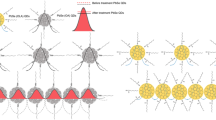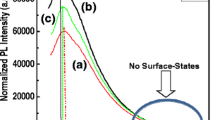Abstract
For an optimum charge/energy transfer performance of hybrid organic–inorganic colloidal nanocrystals for applications such as photonic devices and solar cells, the determining factors are the distance between the nanocrystal and polymer which greatly depends upon nanocrystal size/nanocrystal ligands. Short chain ligands are preferred to ensure a close contact between the donor and acceptor as a result of the tunnelling probability of the charges and the insulating nature of long alkyl chain molecules. Short distances increase the probability for tunnelling to occur as compared to long distances induced by long alkyl chains of bulky ligands which inhibit tunnelling altogether. The ligands on the as-synthesized nanocrystals can be exchanged for various other ligands to achieve desirable charge/energy transfer properties depending on the bond strength of the ligand on the nanocrystal compared to the replacement ligand. In this work, the constraints involved in post-synthesis ligand exchange process have been evaluated, and these factors have been tuned via wet chemistry to tailor the hybrid material properties via appropriate selection of the nanocrystal capping ligands. It has been found that both oleic acid and oleylamine (OLA)-capped cadmium selenide (CdSe) quantum dots (QDs) as compared with trioctylphosphine oxide (TOPO)-passivated CdSe QDs are of high quality, and they provide better steric stability against coagulation, homogeneity, and photostability to their respective polymer:CdSe nanocomposites. CdSe QDs particularly with OLA capping have relatively smaller surface energies, and thus, lesser quenching capabilities show dominance of photoinduced Forster energy transfer between donors (polymer) and acceptors (CdSe nanocrystals) as compared to charge transfer mechanism as observed in polymer:CdSe (TOPO) composites. It is conjectured that size quantization effects, stereochemical compatibility of ligands (TOPO, oleic acid, and oleyl amine), and polymer MEH-PPV stability greatly influence the photophysics and photochemistry of hybrid polymer–semiconductor nanocomposites.











Similar content being viewed by others
References
Huynh WU, Peng X, Alivisatos AP (1999) Adv Mater 11:923–927
Greenham NC, Peng XG, Alivisatos AP (1996) Phys Rev B 54:17628–17637
Seo J, Kim WJ, Kim SJ, Lee KS, Cartwright AN, Prasad PN (2009) Appl Phys Lett 94:133302–133304
Peng Y, Song G, Hu X, He G, Chen Z, Xu X, Hu J (2013) Nanoscale Res Lett 8:106–113
Binetti E, Ingrosso C, Striccoli M, Cosma P, Agostiano A, Pataky K, Brugger J, Curri ML (2012) Nanotechnology 23:075701–075709
Deng S, Lei J, Yao X, Huang Y, Lin D, Ju H (2013) J Mater ChemC 1:299–306
Patidar D, Saxena NS (2013) Adv Nanoparticles 2:11–15
Yuan Y, Krüger M (2012) Polymers 4:1–19
Burda C, Chen X, Narayanan R, El-Sayed MA (2005) Chem Rev 105:1025–1102
Skaff H, Sill K, Emrick T (2004) J Am Chem Soc 126:11322–11325
Wang C, Jiang Y, Li G, Zhang Z, Shi J, Li N (2008) J Cryst Growth 310:2890–2894
Liu J, Tanaka T, Sivula K, Alivisatos AP, Fréchet JMJ (2004) J Am Chem Soc 126:6550–6551
Sharma H, Sharma SN, Singh G, Shivaprasad SM (2007) J Nanosci Nanotechnol 7:1953–1959
Kumari K, Chand S, Kumar P, Sharma SN, Vankar VD, Kumar V (2008) Appl Phys Lett 92:263504–263506
Sharma SN, Pillai ZS, Kamat PV (2003) J Phys Chem B 107:10088–10093
Mehta A, Sharma N. Shailesh, Singh VN, Srivastva AK, Chand S (October 2012) Proc. SPIE. 8549: 16th International Workshop on Physics of Semiconductor Devices 854933–6
Sharma H, Sharma SN, Singh S, Kishore R, Singh G, Shivaprasad SM (2007) Appl Surf Sci 253:5325–5333
Mattaoussi H, Cumming AW, Murray CB, Bawendi MG, Ober R (1998) Phys Rev B 58:7850–7863
Lee CW, Chou CH, Huang JH, Hsu CS, Nguyen TP (2008) Mater Sci Eng B 147:307–311
Pankove JI (1975) Optical processes in semiconductors, 1st edn. Dover, New York, Appendix
Murray CB, Norris DJ, Bawendi MG (1993) J Am Chem Soc 115:8706–8715
Efros AL, Efros AL (1982) Sov Phys Semicond 16:772–775
Zhang JB, Lin Y, Xiao XR, Wang RZ (2005) Thin Solid Films 479:188–192
Rastogi AC, Sharma SN, Kohli S (2000) Semicond Sci Technol 15:1011–1021
Adair JH, Li T, Kido T, Havey K, Moon J, Mecholsky J, Morrone A, Talham DR, Ludwig MH, Wang L (1998) Mat Sci Eng R 23:139–242
Albe V, Jouanin C, Bertho D (1998) Phys Rev B 58:4713–4720
Becerra LR, Murray CB, Griffin RG, Bawendi MG (1994) J Chem Phys 100:3297–3300
Kalsi PS (2002) Spectroscopy of organic compounds. New Age, New Delhi, p 60
Kim BS, Avila L, Brus LE, Herman IP (2000) Appl Phys Lett 76:3715–3717
Shukla N, Liu C, Jones PM, Weller D (2003) J Magn Magn Mater 266:178–184
Sharma SN, Vats T, Dhenadhayalan N, Ramamurthy P, Narula AK (2012) Sol Energy Mater Sol Cells 100:6–15
Sharma H, Sharma SN, Singh G, Shivaprasad SM (2007) Colloid Polym Sci 285:1213–1227
Brinkmann M, Aldakov D, Chandezon F (2007) Adv Mater 19:3819–3823
Lakowicz JR (1999) Principles of fluorescence spectroscopy, 2nd edn. Kluwer-Plenum, New York
Sharma SN (2006) Colloid Polym Sci 284:853–861
Sharma SN, Sharma H, Singh G, Shivaprasad SM (2008) Mater Chem Phys 110:471–480
Kharkwal A, Sharma SN, Chand S, Singh AK (2012) Colloid Polym Sci 290:49–61
Mulazzi E, Ripamonti A, Wery J, Dulieu B, Lefrant S (1999) Phys Rev B 60:16519–16525
Yang SH, Nguyen TP, Le Rendu P, Hsu CS (2005) Thin Solid Films 471:230–235
Sakamoto A, Furukawa Y, Tasumi M (1992) J Phys Chem 96:1490–1494
Zeng QG, Ding ZJ (2004) J Phys Condens Matter 16:5171–5178
Bruevich VV, Makhmutov TSH, Elizarov SG, Nechvolodova EM, Paraschuk DY (2007) J Chem Phys 127:104905–104913
Osotov MO, Bruevich VV, Paraschuk DY (2009) J Chem Phys 131:094906–094910
Bullen CR, Mulvaney P (2004) Nano Lett 4:2303–2307
Puntes VF, Krishnan KM, Alivisatos AP (2001) Science 291:2115–2117
Shoustikov AA, You Y, Thomson ME (1998) IEEE J Sel Top Quantum Electron 4:3–13
Anni M, Manna L, Cingolani R, Valerini D, Creti A, Lomascolo M (2004) Appl Phys Lett 85:4169–4171
Bol AA, Meijerink A (2001) J Phys Chem B 105:10203–10209
LaMer VK, Dinegar RH (1950) J Am Chem Soc 72:4847–4854
Matijevic E (1993) Chem Mater 5:412–426
Van Embden J, Mulvaney P (2005) Langmuir 21:10226–10233
Li G, Shrotriya V, Yao Y, Yang Y (2005) J Appl Phys 98:043704–043708
Kondon M, Kim J, Udawatte N, Lee D (2008) J Phys Chem C 112:6695–6699
Liu Z, Reed D, Kwon G, Shamsuzzoha M, Nikles DE (2007) J Phys Chem C 111:14223–14229
Salgueirino-Maceira V, Liz-Marzn LM, Farle M (2004) Langmuir 20:6946–6950
Acknowledgments
The authors are grateful to the Director, National Physical Laboratory, New Delhi (India) for his kind support. We are thankful to CSIR-India for TAP-SUN program. AM and PC are thankful to MNRE, Govt. of India for financial support.
Author information
Authors and Affiliations
Corresponding author
Rights and permissions
About this article
Cite this article
Mehta, A., Sharma, S.N., Chawla, P. et al. Constraints in post-synthesis ligand exchange for hybrid organic (MEH-PPV)–inorganic (CdSe) nanocomposites. Colloid Polym Sci 292, 301–315 (2014). https://doi.org/10.1007/s00396-013-3073-z
Received:
Revised:
Accepted:
Published:
Issue Date:
DOI: https://doi.org/10.1007/s00396-013-3073-z




